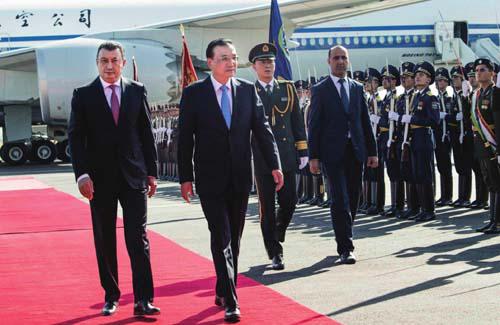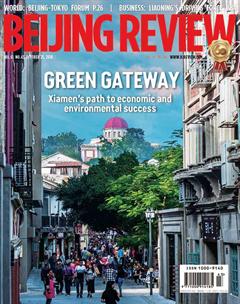Development Equals Stability
By Yu Lintao
Tajikistan abounds in a variety of highquality cantaloupe due to its unique geographical position. However, underdeveloped domestic transportation has long been a hurdle to the delicious fruit being exported to and enjoyed in other parts of the world.
But, since August 2016, when the Vahdat-Yovon Railway started operation, the situation has changed greatly. Constructed with Chinese concessional loans and technology from Chinese companies, the railway—the first since the founding of the republic in 1991—is now well connected with the old railway network from the Soviet Union era.
This has helped Tajikistan become more interlinked and turned the landlocked country into a hub of international railway transportation under the framework of the Belt and Road Initiative, pushing forward the quick development of the resource-rich country by linking it wider to the outside world. The railway has also truly integrated the development of the countrys central region and southern provinces for the fi rst time in history. For quite a long time before the Vahdat-Yovon Railway, cargo and passengers being shuttled by train between the central and southern regions had to travel via a circuitous 432-km route through neighboring Uzbekistan.
Cooperation between China and Tajikistan under the Belt and Road Initiative has also helped the rapid advancement of bilateral relations. In recent years, China has been the main investor in Tajikistans industrial sector including the three priority sectors: energy, transportation and agriculture, aiding in the countrys economic development.
In the meantime, China and Tajikistan have developed a high degree of political mutual trust in the past years, with bilateral relations being upgraded to a comprehensive strategic partnership in 2017, laying a solid foundation for the expansion of relations as well as for trade and economic cooperation. In mid-October, Chinese Premier Li Keqiang paid an official visit to Tajikistan, the first to the Central Asian country after assuming offi ce in 2013, adding new momentum to China-Tajikistan relations.
Comprehensive ties
When meeting with Tajik President Emomali Rahmon, Li stressed that the development prospects of bilateral relations and cooperation are broad given the deep traditional friendship between China and Tajikistan, adding that the two countries have always respected and supported each other and achieved fruitful results from pragmatic cooperation. Noting that they are highly complementary economically, Li called for joint efforts to further cooperation to better achieve win-win results.
Li also promised to encourage more capable Chinese enterprises to invest and start businesses in Tajikistan and said he hopes that Tajikistan will create a more favorable business environment, facilitate customs clearance and improve transportation. He also welcomed more highquality agricultural produce from Tajikistan into the Chinese market.
Chinese companies have invested in many large industrial enterprises and projects in Tajikistan, including Zhongtai(Dangara) New Silk Road Textile Industry Co. Ltd., the largest exporter in Tajikistan in terms of foreign currency earnings, and the Dushanbe-2 thermal power station, which solved the countrys long-existing problem of power shortages in winter. According to Chinese Ambassador to Tajikistan Yue Bin, China has become the largest source of investment in Tajikistan, with a cumulative investment of more than $2 billion.
Rahmon said he believes that Lis visit greatly boosted bilateral ties and cooperation, adding that Tajikistan will firmly cooperate with China in various fields, enhance cooperation in the areas of transportation, agriculture, energy and infrastructure construction, expand people-to-people exchanges and strengthen communication and coordination in regional affairs, so as to deepen the two countries comprehensive strategic partnership.
Moreover, the two countries also agreed to synergize their respective development blueprints and intensify security and anti-terror cooperation together with other countries in the region to safeguard regional peace and stability.
According to Cong Peiying, a researcher with the China Youth University of Political Studies, the practical cooperation between China and Tajikistan has set a good example for cooperation between China and other Central Asian countries, particularly under the framework of the Belt and Road Initiative.
Tajikistan is the first country in the world to have signed a memorandum of understanding with China on jointly building the Silk Road Economic Belt when Chinese President Xi Jinping paid a state visit to the country in 2014.
In addition, supported by the Tajik Government, many roads in the country have been built by Chinese enterprises or with loans provided by the Chinese Government, boosting connectivity among the countrys highways in the north and south, according to the Chinese ambassador.
The infrastructure improvement and energy projects in Tajikistan under the Belt and Road cooperation framework can be a reference for other countries. Furthermore, with more and more roads and railways built with Chinas help, a variety of Tajik products are now delivered to global markets, which also inspires other countries to speed up economic development, Cong said.
Multilateral cooperation
While in Tajikistan, Li also attended the 17th meeting of the Council of Heads of Government of the Shanghai Cooperation Organization (SCO).
One of the major tasks of the meeting was to implement agreements reached in June during the 2018 SCO Summit in Qingdao, east Chinas Shandong Province, which mapped out the course for future development via the Qingdao Declaration and 23 signed cooperation documents.
When addressing the meeting, Li suggested accelerating the start of feasibility studies for an SCO free trade area for closer economic cooperation, adding that China is willing to increase its imports of goodquality agriculture products from other SCO member states.
The Chinese premier said that at a time when economic globalization is facing twists and turns and the multilateral trade system is shaken, SCO member countries, as beneficiaries of global trade liberalization, should continue to firmly support trade liberalization and a rule-based multilateral trade system.
The SCO meeting concluded with a joint communiqué calling on all members to continue the work of consolidating the multilateral trade system and to fight against unilateralism and trade protectionism. SCO leaders also approved a number of cooperation documents in trade and investment, science and technology, and environmental protection.
Deng Hao, Secretary General of the China Center for SCO Studies, said that a distinctive feature of the meeting and the joint communiqué was that they focused on promoting economic cooperation and common development, which is helpful for regional security and stability. The event also offered crucial encouragement for promoting multilateralism and the multilateral trading system guided by the rules of the World Trade Organization.
Cong shared Dengs view. He explained that economic cooperation and development are the basis for social and regional security. By boosting the economy and increasing employment, security can be better achieved as people are able to work and receive an income.
From this perspective, Cong said, the China-proposed Belt and Road Initiative has served as a good platform for deepening cooperation among SCO members.
Deng added that currently, SCO countries are all in a period of political stability with their major task being promoting development. The SCO thus makes promoting common development one of its core missions, conforming to the Shanghai Spirit it advocates and the aspirations of the people of its member states.
At the meeting, Li also proposed advancing cooperation in a number of key areas, including trade, industrial capacity and connectivity, and pledged efforts to make the SCO an exemplar of openness, cooperation and common development.

